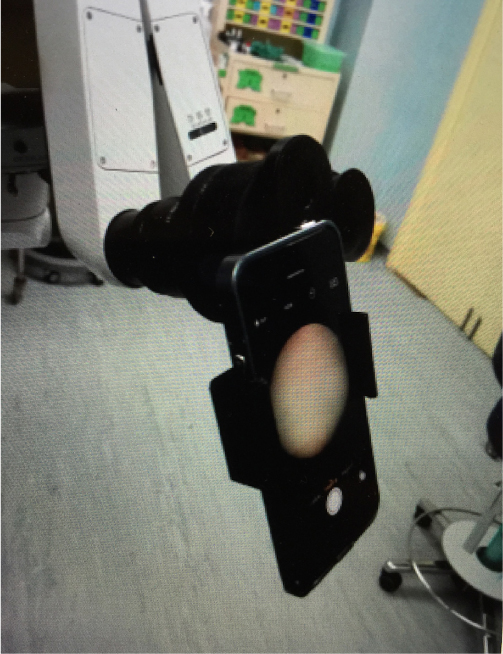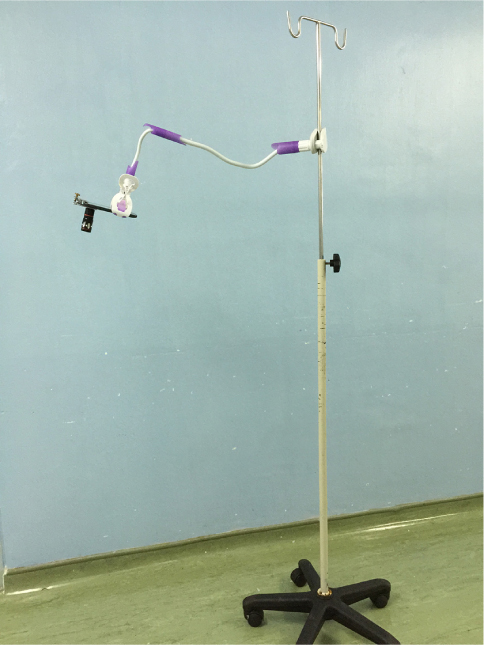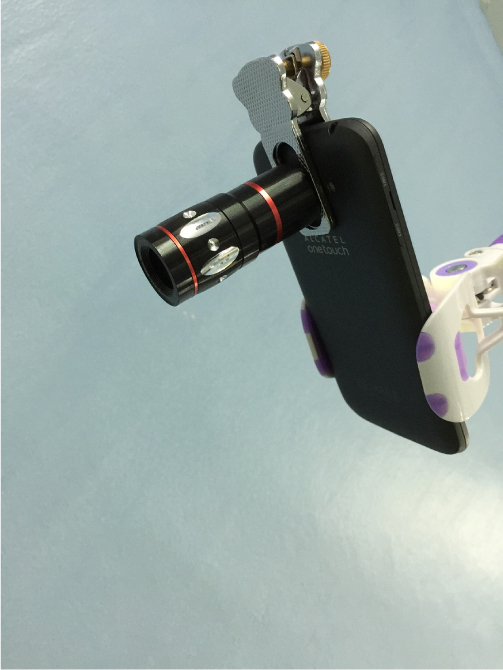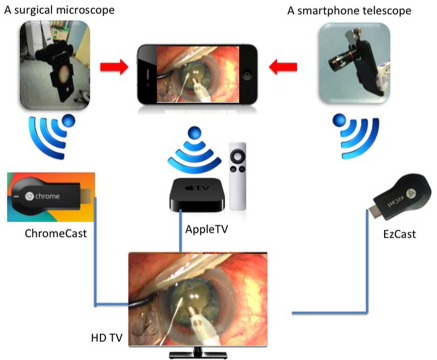Wireless Smartphone Videography for Ocular Surgery SYSTEM
Wireless Smartphone Videography for Ocular Surgery SYSTEM
Jan-Bond Chan, MBBS, MMed Ophthal1,2, Embong Zunaina, MD, MMed Ophthal2, Ismail Shatriah, MD, MMed Ophthal2, Tajudin Liza-Sharmini, MBBS, MMed Ophthal2, Pik-Pin Goh, MD, MS Ophthal3
1Hospital Tuanku Ja’afar Seremban, Negeri Sembilan, Malaysia; 2Universiti Sains Malaysia, Kubang Kerian, Kelantan, Malaysia; 3Clinical Research Centre, Hospital Kuala Lumpur, Malaysia
Corresponding Author: janbond@hotmail.com
Journal MTM 6:1:1–4, 2017
Purpose: To describe a self-made smartphone adaptor which can be attached to a surgical microscope and a smartphone telescope which can be wirelessly linked to an LED TV or monitor.
Methods: A smartphone slit lamp adaptor is built for microscope-assisted ocular surgery in which video can be recorded. For surgeries not utilising the microscope (such as those using surgical loupes), we employed a smartphone attached to a telescope for videography. Videos from both methods are then wirelessly streamed to a TV/monitor using EZCast, Google Chromecast or Apple TV.
Results: The video captured by a smartphone is comparable to conventional digital video recording. It is affordable, easy to use and highly portable.
Conclusion: Smartphone videography will be a valuable instrument in ophthalmology for both teaching and research purpose.
Introduction
Capturing video in ocular surgery in important for both training, research, ethical and legal issues.1 Eye surgeons have been recording their own surgical videos using the conventional video recorders which were incorporated into the surgical microscope. These recorders have evolved from video cassette recorder (VCR) then to digital video recording at present.2
Smartphone ownership has increased exponentially ever since its introduction. In the US, 64% of American adults own a smartphone.3 As of August 2014, 1.64 billion people worldwide own at least one smartphone.4 Smartphones in ophthalmology have been widely used to incorporate apps for diagnostic purposes, referencing, and photography of the anterior and posterior segments of the eye.5 The newer smartphones are capable of capturing superior quality videos of up to 720p and 1080p in high definition (HD). The use of smartphone in capturing surgical videos for archiving and viewing purposes is easy and of superior quality.
With the advancement in technology and availability of high-speed wireless fidelity (wi-fi) connection, video streaming can also be done effortlessly. Video streaming devices like Apple TV, Chromecast and Ezcast are newer methods of wireless video viewing with real-time HD video.
Materials and Methods
For Surgery Requiring Surgical Microscope
We constructed a smartphone adaptor that was able to fit into the assistant viewer eyepiece of our surgical microscope – Leica F40 (Leica, Wetzlar, Germany). It was built from a smartphone casing, sponge (made of Ethylene-vinyl acetate pads) and glue (cyanoacrylate glue).6 After mounting the adaptor, the smartphone was set into the video-taking mode with no further modification needed. It was then wirelessly linked to a device called EZcast which would be plugged into the TV for wireless streaming display.

Figure 1: Smartphone adaptor attached to assistant viewer eyepiece of a surgical microscope
For Surgery Not Requiring Surgical Microscope
We attached an 8x-12x portable telescope (Universal Zoom Telephoto Optical Camera Lens, China) for smartphone and then mount the smartphone to an adjustable smartphone clamp (CTA Digital, Brooklyn, USA). The smartphone clamp was then attached to a standard drip stand for stability.

Figure 2: Smartphone Telescope system attached to drip stand
For Display System
We attached a wi-fi streaming device called EZcast to an LED TV and wirelessly connect the smartphone to the EZCast. Other devices which had similar functionality include the Google Chromecast and AppleTV. These devices assist in streaming video wirelessly to an LED TV. The clarity is of High Definition of up to 720p/1080p.

Figure 3: Smartphone Telescope
For Control of the Recording
In Android OS-based smartphones, a wireless mouse can be easily connected to the smartphone, making control for recording in a remote area easy. The start and stop of a video recording can be controlled just by using a click of the mouse instead of direct contact with the smartphone screen (which may cause image blur due to movements to the smartphone during the video recording).
In the iOS system, additional apps need to be downloaded and tweaked in order to connect the smartphone to a mouse. Subsequently, controlling of the recording is similar to the Android OS system.

Figure 4: Diagram of wireless videography concept
Results
Video quality
We recorded a phacoemulsification surgery. With newer smartphones employing features such as rapid auto-focus and optical image stabilization, videos turned out clear and crisp. The video quality of 720p HD and 1080p HD recording with fast frame rates up to 60 frames per second improves video quality which is compatible to the conventional digital video recording.
Link to sample videos of surgical microscope related surgeries taken with iPhone 5s
Phacoemulsification: https://www.youtube.com/watch?v=5DTsJL5NF7M
Extracapsular Cataract Extraction: https://www.youtube.com/watch?v=capb2ekWvqg
Link to sample videos of non-microscope related surgeries taken with Samsung Note 3
Epiblepharon repair: https://youtu.be/Jzmfl9pBqn4
Squint Surgery: https://youtu.be/lbVoIawn6is
Video Editing
Video editing can be done using additional smartphone apps or the videos can be transferred out from the smartphone for easy editing on a personal computer.
Video Transfer and Sharing
Video transfer has been made much easier with the availability of new social media apps such as Whatsapp and Facebook. With just a click away, the edited video can be shared and transferred.
Discussion
In the era today, most people are very dependent on their smartphones for their daily activities and work. There are several apps which may help in our management and archiving the data of our patient.7,8
With the addition of a few accessories, we converted the smartphone into a clever videography system which will be able to capture high quality videos of ocular surgeries utilising both microscope and non-microscope assistance. This method will be very useful especially in rural areas and developing countries where there is limited access to higher grade video cameras and microscopes.
There is a high potential in this video system as it is portable, affordable and of good quality. Link below shows video comparison of a phacoemulsification surgery taken with a standard Leica video recorder and iPhone 5s simultaneously.
Link of video of side by side comparison between iPhone 5s and Conventional video recorder (Leica) – https://youtu.be/cFoL5T58Zq4
The limitation of this videography system is that the quality of video is high which uses a lot of memory in the smartphone. A surgery which lasts for more than 2 hours may not be ideal for video capturing using standard smartphone as the file will be very large. To improve on the length of video, the capacity of the smartphone memory should be increased or to add in an additional memory card for extra storage.
An informed consent has been taken in all videos taken in the this study. The identity of patients and surgeons remained confidential.
Conclusion
Smartphone videography will be a valuable instrument in ophthalmology for teaching and research.
Acknowledgements
We would like to thank the staff from Hospital Universiti Sains Malaysia and Hospital Tuanku Ja’afar Seremban for assisting in the recording of the surgical procedures shown in the videos.
References
1. Turnbull AM, Emsley ES. Video recording of ophthalmic surgery–ethical and legal considerations. Survey of ophthalmology 2014;59(5):553–8. ![]()
2. Raju B, Raju NS, Raju AS, Sudhakaran CP, Razak A. Digital video recording and archiving in ophthalmic surgery. Indian journal of ophthalmology 2006;54(1):53–7. ![]()
3. Pew Research Centre. U.S. Smartphone Use in 2015. Survey. 2015 1 April 2015. Report No.
4. eMarketer. Smartphone users and penetration worldwide. Dec, 2014.
5. Chhablani J, Kaja S, Shah VA. Smartphones in ophthalmology. Indian journal of ophthalmology 2012;60(2):127–31. ![]()
6. Chan JB, Ho HC, Ngah NF, Hussein E. DIY-Smartphone Slit-Lamp adaptor. Journal of Mobile Technology in Medicine. 2014;3(1):16–22. ![]()
7. Zangbar B, Pandit V, Rhee P, et al. Smartphone surgery: how technology can transform practice. Telemedicine journal and e-health: the official journal of the American Telemedicine Association 2014;20(6):590–2. ![]()
8. Fischer I, Gick S, Steiger HJ. Monitoring Recovery after Elbow Surgery Using Smartphone. Biomedizinische Technik Biomedical engineering. 2013. ![]()

